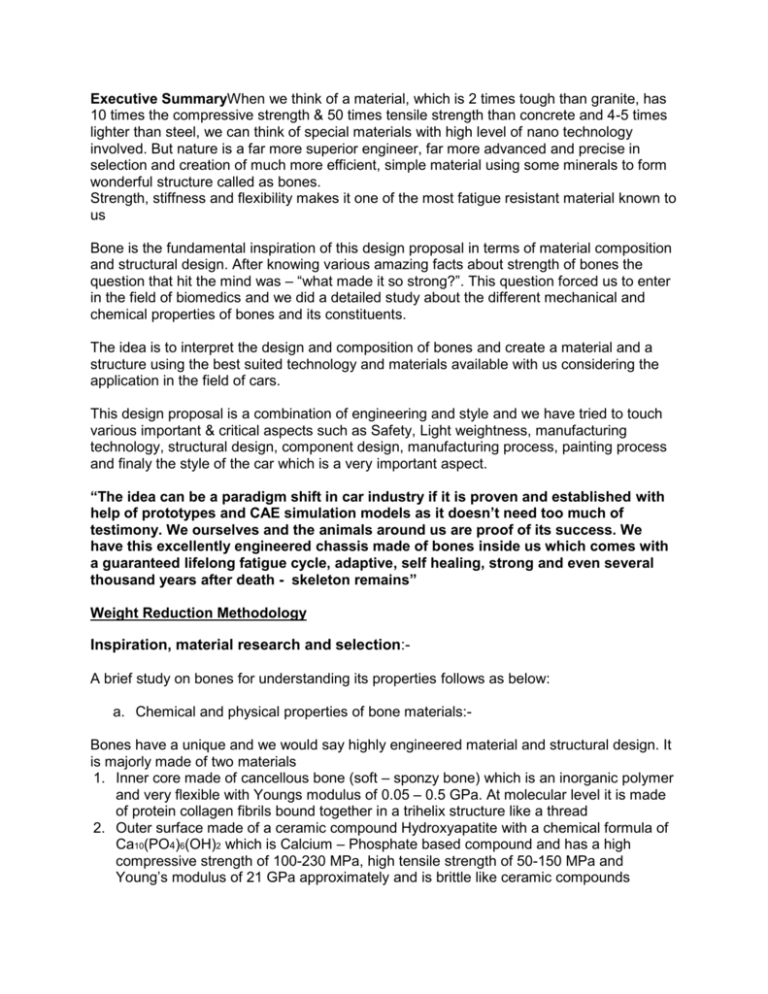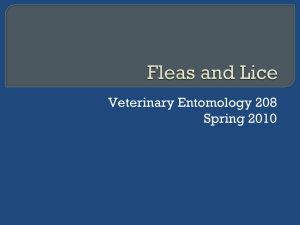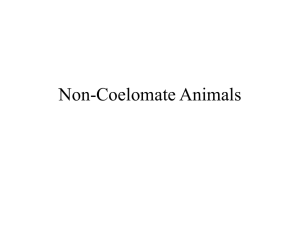Executive Summary When we think of a material, which is 2 times
advertisement

Executive SummaryWhen we think of a material, which is 2 times tough than granite, has 10 times the compressive strength & 50 times tensile strength than concrete and 4-5 times lighter than steel, we can think of special materials with high level of nano technology involved. But nature is a far more superior engineer, far more advanced and precise in selection and creation of much more efficient, simple material using some minerals to form wonderful structure called as bones. Strength, stiffness and flexibility makes it one of the most fatigue resistant material known to us Bone is the fundamental inspiration of this design proposal in terms of material composition and structural design. After knowing various amazing facts about strength of bones the question that hit the mind was – “what made it so strong?”. This question forced us to enter in the field of biomedics and we did a detailed study about the different mechanical and chemical properties of bones and its constituents. The idea is to interpret the design and composition of bones and create a material and a structure using the best suited technology and materials available with us considering the application in the field of cars. This design proposal is a combination of engineering and style and we have tried to touch various important & critical aspects such as Safety, Light weightness, manufacturing technology, structural design, component design, manufacturing process, painting process and finaly the style of the car which is a very important aspect. “The idea can be a paradigm shift in car industry if it is proven and established with help of prototypes and CAE simulation models as it doesn’t need too much of testimony. We ourselves and the animals around us are proof of its success. We have this excellently engineered chassis made of bones inside us which comes with a guaranteed lifelong fatigue cycle, adaptive, self healing, strong and even several thousand years after death - skeleton remains” Weight Reduction Methodology Inspiration, material research and selection:A brief study on bones for understanding its properties follows as below: a. Chemical and physical properties of bone materials:Bones have a unique and we would say highly engineered material and structural design. It is majorly made of two materials 1. Inner core made of cancellous bone (soft – sponzy bone) which is an inorganic polymer and very flexible with Youngs modulus of 0.05 – 0.5 GPa. At molecular level it is made of protein collagen fibrils bound together in a trihelix structure like a thread 2. Outer surface made of a ceramic compound Hydroxyapatite with a chemical formula of Ca10(PO4)6(OH)2 which is Calcium – Phosphate based compound and has a high compressive strength of 100-230 MPa, high tensile strength of 50-150 MPa and Young’s modulus of 21 GPa approximately and is brittle like ceramic compounds b. Structural composition What makes it interesting is the structural composition: 1. Outer layer: The outer layer of bone is a highly dense thin layer of Hydroxyapatite and is responsible for the high compression strength, rigidity & toughness. 2. Inner layer: The inner core is made of a cellular honeycomb 3 dimensional matrix made of collagn fibres giving a high overall bonding, lightweightness and high tensile strength The hydroxyapatite crystals are wrapped around the collagen fibrills at a micro level making the bonding very natural and strong nterpretation method followed: Honey comb being excellent structures know for its high strength to weight ratio and shock absorbtion capabilities is a well known and engineering fact. Therefore it finds well its application in the field of Aerospace, and super sports car for light weightness and most important for safety due to high shock absorbtion during collision. The material which is fibrous and very flexible with a low youngs modulus acts as a perfect material to form a uniform but strong flexible structure having high tensile strength and yield strength. But honeycomb being less effective in compressive strength and bending moments along the longitudinal direction of cells needs to be supported by another layer of material which has a high compressive strength. At the same the layered material should be very close in terms of chemical bonding, thermal expansion behaviors. Therefore the ideal composition and secret formula is a 3 dimensional honey comb matrix made of a lightweight flexible material such as polymer surrounded by a dense thin layer of hard, tough, strong and light weight material such as ceramic. The resulting structure will be exhibit unique properties as: 1. High compressive strength 2. High tensile strength 3. High fracture toughness 4. High rigidity 5. High flexibility 6. Ultra lightweight 7. High shock absorbtion capability 8. Overall high strength to weight ratio 9. Anisotropic properties HYBRID MATERIAL PROPOSAL: If we see the all properties above, they are the fundamentally most required properties in car material. The material has to be strong, lightweight, shock absorbing, rigid and flexible at the same time and resistant to fatigue failure. Therefore based on the above research and interpretation we are proposing the composition of hybrid material as below: 1. Polypropylene(PP): Being an inorganic polymer with density of 0.95 gm/cm3, Tensile strength of 20-80 MPa, compressive strength of 40 MPa and Youngs modulus of 1.5-2 which are much similar to the Collagen properties. Polypropylene polymers are widely being used in Car industry for its high strength and metal like properties 2. Tricalcium Phosphate(TCP): A ceramic compound having almost same properties as Hydroxapatite. It’s a challenge to use it in cars as never thought of!! **During the research we have found that in the field of biomedics, there is a huge research being done in the field of orthopedics to find a material as a replacement of bones and there are some given examples to use above composition of TriCalcium phosphate and Polyprolyene for artificial bones but currently is a field of challenge in terms of manufacturing and fusion So the big question which is raised is that why we propose to use multi-material compostition and not uniform single material which is current trend ? Well the answer is that while using a uniform single material as Steel, Aluminium alloy, carbon fibre, graphene, or Fibre reinforced plastics: the advantage is lightweightness and high strength but these materials have certain disadvantages: 1. Steel being hard, tensile, and strong is the most widely used material in Automobile field for over almost a century. But the material is heavy, prone to corrosion and exhibit very low shock absorbtion capabilities 2. Aluminium alloys at the same time are lightweight, strong but are difficult to manufacture in terms of welding as the electrical resistance is very low and needs a very high amount of electric current for fusion of joints. 3. Carbon fibres are the latest and technologically proven materials and widely used in space and sports cars for its ultra high strength to weight ratio and a high compressive strength of 1600-4000 MPa. But at the same time the major disadvantage being high conductive, difficult to paint, very brittle and ultra high manufacturing cost. 4. Other nano fibres such graphene being very strong and light weight is evolving and is under exploration but has challenge of 3 dimensional matrix layout as it is basically single atom layer compound which makes it extremely suitable for electrical applications and used in batteries. 5. Fibre reinforced plastics are widely used in automobile industry and are seen as a replacement material for several skin panels due to lightweightness medium strength, resistant to temperature, anti-rust and neutral to environment making it very life long. But disadvantage being low compressive strength and low toughness and are crack prone So what makes it Light weight? 1.Average material density 1/3rd of steel: With Polyproylene having density of 0.95 gm.cm3 and TCP – 3.14 gm/cm3 we can assume approximate combined density around 2.5 gm/cm3 which is about 1/3rd of steel 2.Honey comb internal structure: The structural member will be constructed of an inner core of 3 dimensional cellular matrix of Polypropylene fused with the ceramic compound Tri Calcium Phosphate. The structure being porous due to honey comb with an approximate porosity of 30-35% will result in extremely light weight and ultra high strong structure. 3.Varied density across cross section: The composition of the material will vary from inner to outer with Polypropylene (PP) maximum at inner surface to Tri Calcium Phosphate maximum at the outer layer. The combination of soft flexible and hard tough will make the structure act like bones. 4.Varied honey comb density across length of material: The honey comb density will vary from section to section depending on the load requirements of parts with optimized material consumption Innovation Major innovation elements: 1. Ultra lightweight & strong internal honey-comb cellular structure using 3d printing: Using 3d printing technology(explained in manufacturing section) the unique internal honey comb structure can be created which cannot be created otherwise with any other manufacturing technology available currently. Only nature can produce such structures. The idea best uses the wonderful and immense capability of 3d printing 2. Varied material composition across single cross section plane: Again the 3d printing technology capabilities are being used extensively here as the material composition changes as we move across the cross section from inner section to outer. The idea is unique in terms of using different materials in single cross section. 3. Varied honeycomb cell density across length of vehicle: Using the 3d printing technology the honey comb cell densities can be varied easily across the length of the vehicle as per the structure requirements with high stress prone areas with dense and compact hiney comb cell density. This capability has been well used for safety enhancement explained in the safety section below 4. Continuous uniform joint free junctions: There are no joints but free flowing smooth surfaces. This makes the whole body act as a single component and extremely strong as the stresses are not concentrated on one point but are uniformly distributed over all the members. 5. Unique B pillar, front engine compartment and Roof header design for enhanced safety and improved crash protection (explained in next section). All these above ideas have been explained with images in the main slides attached Bill of Materials Required Manufacturing Processes Fixed deposition of Ceramics (FDC) - 3d printing: The idea is to use fused deposition of ceramics (FDC) type 3d printing technology to create fusion of Polypropylene (PP) filament drawn from wire spool and Tri Calcium phosphate (TCP) ceramic powder. Some bonding materials might be required. Combining the polymer and ceramic with interlinked bond using a 3d printing is a challenging task and is an area of intensive research and testing. The complete bodyshell being is a uni body monocoque will be produced with FDC 3d printer as one single component. The body itself is very unique and with no joints and can be well produced using 3d printing technology. The panels like roof, tailgate, bonnet, doors will be printed using the same method in a separate machine for simultaneous production. Technologies to be developed: 1.Advanced FDC 3d printer: Fusion of materials with very different properties, one being a polymer and other being a ceramic is very challenging. Normally both are produced using 3d printing using different FDM based for PP and Laser sintering based for TCP. Making a 3d printer itself for creating such varied amount of composition of material across single cross section with precise, fine level and fast speed is the greatest need for its feasibility. 2.Computer generated 3d model with internal 3-d honeycomb cellular matrix: Honecomb cellular structures do exist and we can see it very well but are very hard to create using 3d CAD modeling as the cells are interconnected in all the three x,y,z planes. In addition to this complexity the material composition varies and the honeycomb cell size varies across cross section and length making the design by human hands extremely difficult. One possible solution could be using computers program based on pure mathematical solutions and complex equations or logic driven from fibonacci series. The inputs given by us will be a. Contours of the body as single line or wireframe models showing the key members and joints with specified overall dimension of car b. Overall loads of vehicles ad critical areas definition with respect to safety and crash Based on the above two elements computer could generate the 3d molecular model which can be feeded to 3d printer. The concept is very theoretical but is possible with some good brains behind its development. Passenger Safety Safety is the most important and wells researched aspect of this vehicle and we a unique and innovative proposal using capabilities of 3d priniting technology: 1.Frontal crash: We all know that crumple zones are created in front cross members of chassis in cars to absorb shocks created by impact during head on collision. As the whole material proposed in itself is made of inner cellular honey comb, four different special bulged sections have been created as shown in the slides (section z-z). The bulged volume grows gradually from uniform section of material to enlarged section and again merges back to the original section uniformly. This bulge section has a compact and uniform grid of honey comb cells and can absorb large amount of shocks during collision. Also the honey comb cells will provide the strength to the overall structure. Explained in z-z section in slides 2.Side way collision: During the side way collision the B-pillar member is the most critical and has to be very rigid and needs high bending strength to keep the passenger cabin safe and has to be shock absorbing. Because of these in conventional cars we use B pillar made of box section made of inner and outer layers made of different grade dual phase steels making the design very complicated & heavy component. We try to solve this problem of high bending strength and shock absorbing by creating a unique honey comb I-beam formation inside the B pillar. Explained in detail with diagrams in the section x-x view in the slides. During impact the I beam formation acts as anti-bending structure and at the same time the honey comb structure acts as a mini crumple zone within the top and bottom section to absorb the shock in longitudinal direction of B pillar. The different material composition at the outer surface and inner surface also serves different purpose well explained in the diagrams. The shock absorption property prevents the passengers from internal injury due to very high impulsive forces. The structure is highly efficient and lightweight. Similar design implemented for door intrusion beams 3.Roll over accident:During rollover the top roof header B pillar takes the maximum load and transfers to the B pillar member to protect from roof collapse. We proposed the similar B pillar Honey comb I beam formation section to absorb the impact as well as high bending strength. The smooth B-pillar joint with roof header will help in the distribution of forces. The uniform material junctions help in distribution of forces in all directions uniformly maintaining cabin safety. Explained in detail with diagrams in y-y section in slides. Innovative/Safety Component 1. Light weight: Adressing the best possible use of 3d printing technology by creating a honey comb structure within the members through out the body with combination of varied cell densities and material composition makes the whole vehicle extremely light weight, strong and durable. Approximately 30 % reduction in weight reduction can be achieved (calculation sheet attached for reference) 2. Safety: The unique design of B pillar, roof bow with I beam formation and honey comb structure crumple zones creates the anti bending and shock absorbing effects which are the primary requirements of passenger safety. The creation of gradual and elongated front end honey comb crumple zone is another innovation element. . Potential Challenges 1. Technology constraints 3-D printers: The idea of fusing polymer with ceramic is very theoretical and relies totally upon the capabilities of 3d printers. The printers have to be very fast, smart, precise, and material fusion systems has to be very active at a micro level to fulfill the need of mixing materials across any cross section and varying the material flow to change the honey comb cell density at any point of time. 2. Extremely difficult 3d mode: Creating a 3 d model with internal honey comb cell is another challenge as the honey combs are 3 dimensional cellular chains. It is very difficult to create 3d model with a human hand and needs advanced computers with mathematically driven programs to create generative internal structure. 3. The material selection however is theoretically correct but its feasibility has to checked by creating prototype samples and subjected to test for various load conditions. TCP being a calcium based compound has to be well tested in different conditions for any chemical reaction leading to weakness. The material however can be protected well by adding a small micro layer of Poly propylene at the final stage of printing giving it an aesthetic look as well. A slide related to painting has been added 4. Fusing the nut bolts for seat belts, passenger seats, powertrain , suspensions with the proposed material is again an area of concern. Special fastners has to be designed and validated or a method to mix metal fasteners has to be explored.





